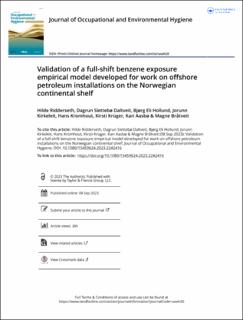| dc.contributor.author | Ridderseth, Hilde | |
| dc.contributor.author | Daltveit, Dagrun Slettebø | |
| dc.contributor.author | Hollund, Bjørg Eli | |
| dc.contributor.author | Kirkeleit, Jorunn | |
| dc.contributor.author | Kromhout, Hans | |
| dc.contributor.author | Krüger, Kirstin | |
| dc.contributor.author | Aasbø, Kari | |
| dc.contributor.author | Bråtveit, Magne | |
| dc.date.accessioned | 2023-10-05T12:13:52Z | |
| dc.date.available | 2023-10-05T12:13:52Z | |
| dc.date.created | 2023-09-28T08:59:39Z | |
| dc.date.issued | 2023 | |
| dc.identifier.issn | 1545-9624 | |
| dc.identifier.uri | https://hdl.handle.net/11250/3094504 | |
| dc.description.abstract | Workers on offshore petroleum installations might be exposed to benzene, a carcinogenic agent. Recently, a full-shift benzene exposure model was developed based on personal measurements. This study aimed to validate this exposure model by using datasets not included in the model. The exposure model was validated against an internal dataset of measurements from offshore installations owned by the same company that provided data for the model, and an external dataset from installations owned by another company. We used Tobit regression to estimate GM (geometric mean) benzene exposure overall and for individual job groups. Bias, relative bias, precision, and correlation were estimated to evaluate the agreement between measured exposures and the levels predicted by the model. Overall, the model overestimated exposure when compared to the predicted exposure level to the internal dataset with a factor of 1.7, a relative bias of 73%, a precision of 0.6, a correlation coefficient of 0.72 (p = 0.019), while the Lin’s Concordance Correlation Coefficient (CCC) was 0.53. The model underestimated exposure when compared to the external dataset with a factor of about 2, with a relative bias of −45%, a precision of 1.2, a correlation coefficient of 0.31 (p = 0.544), and a Lin’s CCC of 0.25. The exposure model overestimated benzene exposure in the internal validation dataset, while the precision and the correlation between the measured and predicted exposure levels were high. Differences in measurement strategies could be one of the reasons for the discrepancy. The exposure model agreed less with the external dataset. | en_US |
| dc.language.iso | eng | en_US |
| dc.publisher | Taylor & Francis | en_US |
| dc.rights | Navngivelse 4.0 Internasjonal | * |
| dc.rights.uri | http://creativecommons.org/licenses/by/4.0/deed.no | * |
| dc.title | Validation of a full-shift benzene exposure empirical model developed for work on offshore petroleum installations on the Norwegian continental shelf | en_US |
| dc.type | Journal article | en_US |
| dc.type | Peer reviewed | en_US |
| dc.description.version | publishedVersion | en_US |
| dc.rights.holder | Copyright 2023 the authors | en_US |
| cristin.ispublished | true | |
| cristin.fulltext | original | |
| cristin.qualitycode | 1 | |
| dc.identifier.doi | 10.1080/15459624.2023.2242416 | |
| dc.identifier.cristin | 2179688 | |
| dc.source.journal | Journal of Occupational and Environmental Hygiene | en_US |
| dc.identifier.citation | Journal of Occupational and Environmental Hygiene. 2023. | en_US |

